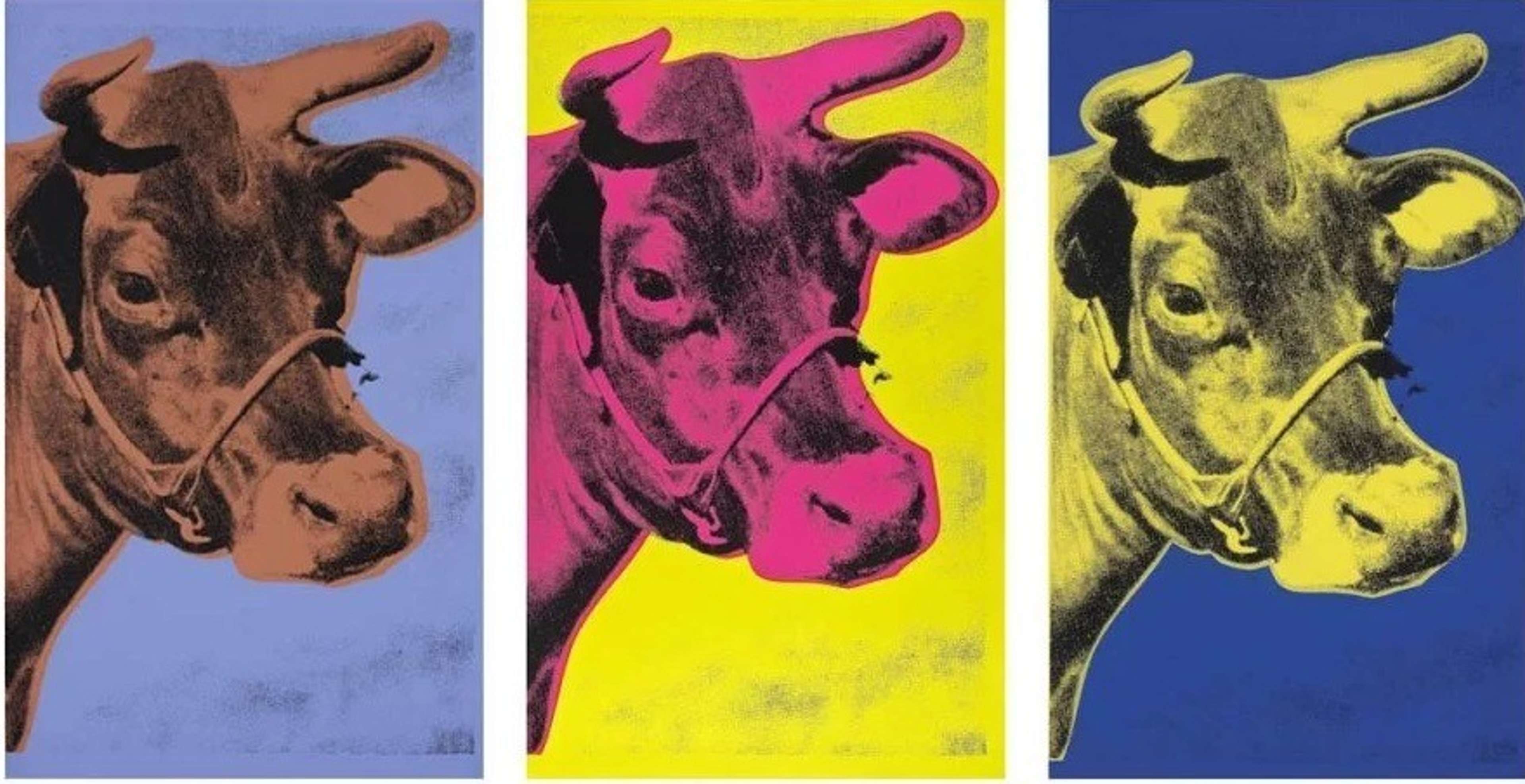 Cow (F. & S. II.11) © Andy Warhol 1966
Cow (F. & S. II.11) © Andy Warhol 1966
Interested in buying or selling
Andy Warhol?

Andy Warhol
487 works
Between 1966-76, Andy Warhol produced four Cow prints. The artificial colourful Cow has become one of the most recognisable images in Warhol's oeuvre, and documents Warhol's career-defining turn to screen printing.
Warhol's Cows were inspired by the art dealer Ivan Karp.
 Cow (F. & S. II.11A) © Andy Warhol 1971
Cow (F. & S. II.11A) © Andy Warhol 1971Ivan Karp, renowned Pop Art dealer of the 1960s, inspired Warhol's Cow works after a flippant conversation about Warhol's subject matter. As Warhol recollected, “another time he said, ‘Why don't you paint some cows, they're so wonderfully pastoral and such a durable image in the history of the arts.’” Under Karp's influence, Warhol inserted his unnaturally coloured cows into this art historical lineage.
The Cow screen prints were made into wallpaper.
 Cows © Andy Warhol 1966
Cows © Andy Warhol 1966For his 1966 exhibition at the Leo Castelli Gallery, Warhol had an entire room of the gallery covered in a wallpaper of his pink and yellow Cow. From floor to ceiling, the screen printed image was repeated over and over to create a dizzying kaleidoscope of cows. The concept bordered on the absurd, but showcased Warhol's penchant for screen printing which would come to define him as an artist.
Warhol transformed the ‘pastoral‘ cow into a ‘vulgar‘ creature.
 Cow (F. & S. II.11) © Andy Warhol 1966
Cow (F. & S. II.11) © Andy Warhol 1966Though Karp had convinced Warhol to depict cows for their ‘pastoral‘ appeal, Warhol worked to make his Cow as unnatural as possible. Though Karp was shocked when he first saw Warhol's conception, Warhol remembered, “after a moment he exploded with: ‘They're super-pastoral! They're ridiculous! They're blazingly bright and vulgar!’ I mean, he loved those cows and for my next show we papered all the walls in the gallery with them.”
There is a universality to Warhol's Cow.
 Pears (F. & S. II.203) © Andy Warhol 1979
Pears (F. & S. II.203) © Andy Warhol 1979Like the majority of Warhol's mass-media inspired oeuvre, Cow is a work of art which demands no context. By representing the big brands, celebrities and current affairs of his time, Warhol created a genre of art which could be read and understood by the masses. Cow is a perfect example of Warhol's commitment to making art that is universal and engaging.
The cow photograph was selected by Warhol's printer, Gerard Malanga.
 Cow (F. & S. II.12) © Andy Warhol 1971
Cow (F. & S. II.12) © Andy Warhol 1971Warhol's psychedelic and whimsical Cow prints, like the majority of his printed works, were created using a pre-existing photograph. The original photograph of Warhol's sedate cow was chosen by his printer, Gerard Malanga. The series is therefore testament to the importance of collaboration in Warhol's work.
Cow wasn't Warhol's only animal series.
 Black Rhinoceros (F. & S. II.301) © Andy Warhol 1983
Black Rhinoceros (F. & S. II.301) © Andy Warhol 1983Warhol had a particular fondness for animals, and created multiple animal portrait series throughout his career. While his favourite animal was perhaps the cat, as we see in his sentimental Cats Named Sam series, he rendered a selection of Endangered Species in 1983 to raise awareness of their extinction.
Cow marks a turning point in Warhol's career.
 Campbell's Soup I, Vegetable Made With Beef Stock (F. & S. II.48) © Andy Warhol 1968
Campbell's Soup I, Vegetable Made With Beef Stock (F. & S. II.48) © Andy Warhol 1968In the same year that this series was created, Warhol declared that painting was ‘dead‘. Warhol turned his back on tradition, and committed himself to creating his art primarily via screen prints. Warhol's unprecedented and revolutionary approach forced his contemporaries to reconsider what ‘art‘ actually is, and broke the distinctions between what was regarded as ‘high‘ and ‘low‘ visual culture.
Warhol's Pink Cow On Purple Background was published for and exhibition at The Modern Art Pavilion.
 Cow (F. & S. II.12A) © Andy Warhol 1976
Cow (F. & S. II.12A) © Andy Warhol 1976Published in November 1976, Warhol's Pink Cow On Purple Background was the last iteration of his Cow. Produced for an exhibition at The Modern Art Pavilion in Seattle, the colourful work was printed as an edition of around 100, all signed by Warhol in black felt-tip.
Cow is one of the most popular works in Warhol's oeuvre.
 Marilyn (F. & S. II.31) © Andy Warhol 1967
Marilyn (F. & S. II.31) © Andy Warhol 1967Though the subject matter of this series was atypical of Warhol, the Pop Art Cow is one of his most revered prints. The work also marks a significant point in Warhol's career, as he fine-tuned his method of screen printing that would come to define the entire genre of Pop Art.
The series encapsulates Warhol's ethos of screen printing.
 Flowers (F. & S. II.6) © Andy Warhol 1964
Flowers (F. & S. II.6) © Andy Warhol 1964Quickly reproducible and allegedly ‘vulgar‘, Cow encapsulates the traits of mass media and pop culture that inspired Warhol's oeuvre in its entirety. After he produced his first Cow in 1966, Warhol turned his full attention to screen printing and catalysed the ‘print boom‘ of the 1960s.
